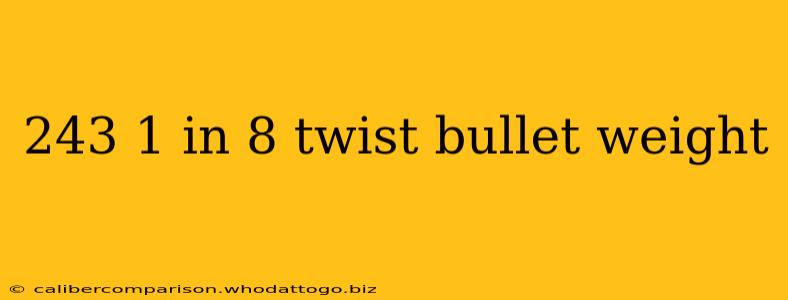The world of ballistic calculations can be daunting, especially for newcomers. Understanding specifications like "243 1 in 8 twist" and its relationship to bullet weight is crucial for accurate shooting. This guide will break down these terms, explain their significance, and help you choose the right ammunition for your firearm.
What Does "243" Refer To?
The "243" refers to the .243 Winchester cartridge, a popular and versatile round known for its accuracy and relatively low recoil. It's a favorite among hunters and target shooters alike, offering a balance of power and precision.
Understanding Barrel Twist Rate: 1 in 8
The "1 in 8 twist" describes the rifling inside the barrel of your rifle. Rifling is the spiral groove cut into the barrel's interior. This spiral imparts spin to the bullet as it travels down the barrel, stabilizing it in flight and enhancing accuracy.
The "1 in 8" designation means the bullet completes one full rotation every 8 inches of travel down the barrel. A faster twist rate (like 1 in 7 or 1 in 6) is necessary to stabilize heavier and longer bullets. Conversely, a slower twist rate (1 in 10 or 1 in 12) is suitable for lighter bullets.
Matching Bullet Weight to Twist Rate: Crucial for Accuracy
Choosing the correct bullet weight for your rifle's twist rate is paramount for achieving optimal accuracy. If the twist rate is too slow for the bullet's weight and length, the bullet will not stabilize properly, leading to poor accuracy and potentially dangerous keyholing (the bullet impacting the target sideways). Conversely, a twist rate that's too fast isn't as problematic, but it can lead to slightly increased recoil and potentially slightly reduced velocity.
For a .243 Winchester with a 1 in 8 twist barrel, you have a wide range of bullet weight options available. Generally, a 1 in 8 twist is considered a fast twist rate, capable of stabilizing a broad spectrum of bullet weights, from lighter varmint rounds to heavier bullets for deer hunting. However, extremely heavy bullets may still experience instability, depending on their length and design.
Bullet Weight Considerations for a .243 Winchester with 1 in 8 Twist
While a 1 in 8 twist in a .243 Winchester is quite versatile, it's essential to consult the manufacturer's recommendations for your specific rifle. They will usually specify a recommended bullet weight range. However, as a general guideline, you'll find excellent results with bullets ranging from approximately 55 grains up to around 100 grains. Anything outside this range might require experimentation to determine stability.
Factors Affecting Bullet Stability Beyond Weight and Twist:
- Bullet Length: A longer bullet, even if lighter, might require a faster twist rate to stabilize than a shorter, heavier bullet.
- Bullet Shape: The bullet's shape and design (e.g., boat tail, hollow point) influence its stability in flight.
- Bullet Construction: The materials used in the bullet's construction also play a role in its overall stability.
Finding the Right Ammunition
Always check the manufacturer's recommendations for your specific firearm before selecting ammunition. Experimentation with different bullet weights within the safe operating parameters of your rifle is a common practice for fine-tuning accuracy. Start with bullets within the generally accepted range for your barrel's twist rate, and then fine-tune based on your shooting experience. Remember safety is paramount, always follow safe firearm handling practices.

